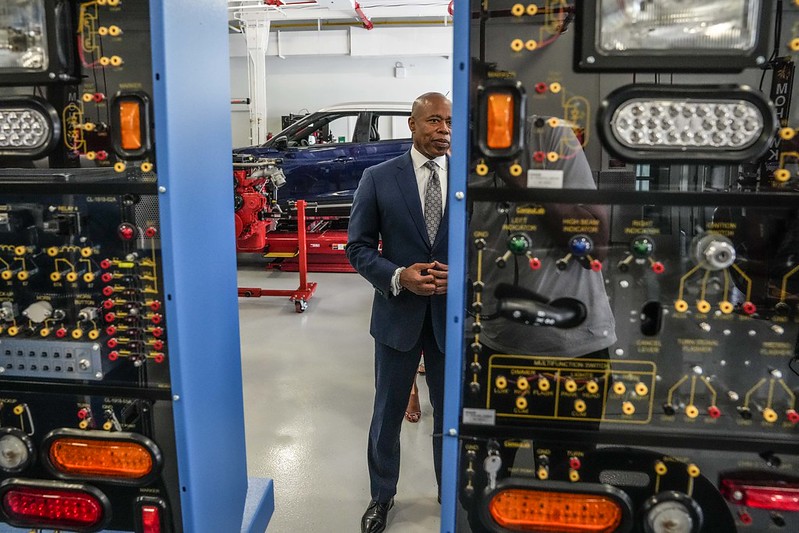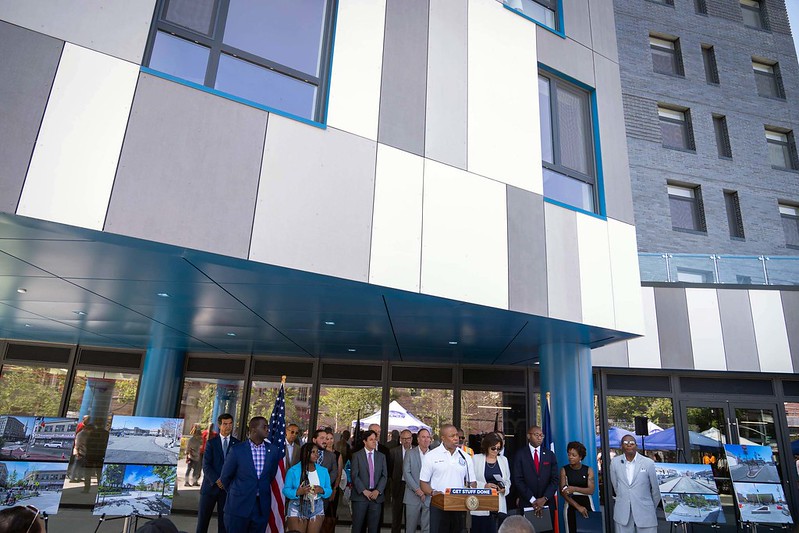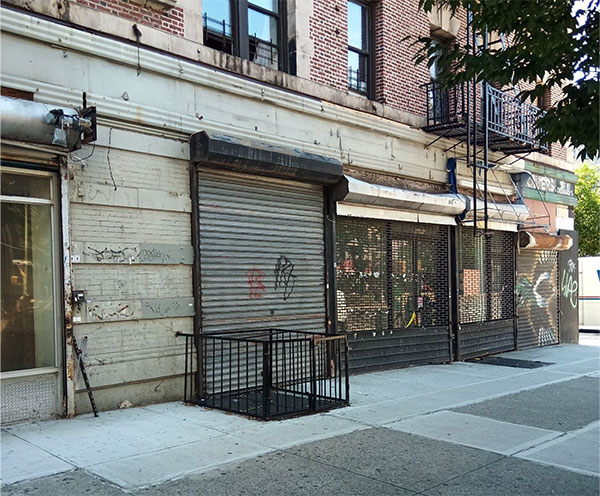Boost NYC’s Tech Sector to Ensure a Full Jobs Recovery and Stronger Future for New Yorkers

Mayor Adams sees tech jobs in action (photo: Michael Appleton/Mayoral Photography Office)
It's now clear that predictions of economic doom for New York made in the early days of the pandemic were as far off as, well, forecasts of the city’s demise made after 9/11 and the Great Recession. But while there are numerous signs that the city is bouncing back strong—from an uptick in tourism to sky-high demand for apartments—New York still has a long way to go in its employment recovery. Indeed, the city still has 123,000 fewer jobs than it did in February 2020, regaining just 82% of the jobs lost in the pandemic (compared to 100% for the nation).
There are many things city policymakers can do to spark a more complete jobs recovery, but few are as likely to succeed as supporting the continued growth of the tech sector.
Tech has been a force in the city’s economy for well over a decade. But in recent years, the tech sector has reached another level, becoming New York’s single most important job engine, and the most reliable source of new well-paying jobs. In fact, the tech sector has accounted for a remarkable 17% of the city’s entire private sector job growth since 2010, growing seven times as fast as the city’s overall economy.
It’s also been creating loads of well-paying jobs at a time when the city’s more traditional sources of good jobs have seen much slower growth. While the tech sector added 114,000 jobs in the city over the past decade, the construction industry created 29,000 jobs, the film and tv sector 19,000, the securities industry 17,000, hospitals 4,000, and law firms 3,000. Manufacturing jobs in the city declined by 20,000.
The tech sector has also outpaced all other major industries during the pandemic, with employment in the sector increasing by 8.7% since February 2020, a period when overall private sector employment in the city declined by 5.3%.
Although some tech fields face headwinds today, many others are on the cusp of significant growth. As one sign of the enormous potential, the number of start-ups has increased by at least 35% in 37 different tech sub-sectors over the past 5 years—from artificial intelligence and e-learning to ‘women’s and family’ tech.
As much as New York needs this tech growth to continue, it is by no means a given. Indeed, New York is facing new challenges that emerged during the pandemic that could dampen the sector’s growth here.
For one, remote work has made it easier than ever for tech workers—and the companies that employ them— to locate wherever they want, making it increasingly important for New York to be a leader in quality-of-life issues. Moreover, just as workers are more mobile than ever, New York is facing growing competition from several other cities that—unlike ten years ago—now boast dynamic tech ecosystems of their own, as well as significantly more affordable real estate. The departure of several tech companies from San Francisco since the pandemic arrived is a cautionary tale.
New York can overcome these and other challenges. But it will require a level of support from city policymakers that matches the new economic importance of the tech sector.
Mayor Adams has already been an enthusiastic and supportive champion for New York’s tech sector. Other parts of city and state government will need to follow suit. The wrong economic development, regulatory, and legal policies could cause the city to miss out on the sector’s extraordinary potential for future job growth.
There are several specific steps city officials should take to keep the tech sector growing, but the three most important actions involve people:
First, prioritize investments in parks, transit, safety, culture, and affordability—all of which are key to retaining and attracting talent, the key to New York’s continued strength as a tech hub.
Second, ramp up investments that will greatly expand access to tech careers for New Yorkers, including new investments in computing education in the schools, scaling up the most effective tech training programs, and harnessing CUNY as a springboard into tech roles.
Third, position New York to become the best place in the nation to work from home. This might include investing in new pocket parks and open spaces in residential neighborhoods, bolstering high-speed Internet service, and eliminating barriers for property owners outside of Manhattan to convert first- or second-floor retail space into hubs for communal office work.
By taking these steps, New York can turbocharge the city’s jobs recovery and build a larger and more inclusive tech ecosystem for the long run.
***
Jonathan Bowles is Executive Director of the Center for an Urban Future. Jason Myles Clark is Executive Director of Tech:NYC. On Twitter @jbowlesnyc of @nycfuture and @jasonmylesclark of @TechNYC.
***
Have an op-ed idea or submission for Gotham Gazette? Email This email address is being protected from spambots. You need JavaScript enabled to view it.
It's Time to Separate Housing from Politics

Housing (photo: Ed Reed/Mayoral Photography Office)
It’s time for New York to depoliticize housing.
Population growth across the five boroughs has so badly outpaced housing production over the last decade that the city needs more than half a million new units by 2030.
A new report by the nonpartisan Citizens Budget Commission (CBC) slammed the process through which the city decides to approve or reject the kinds of development projects that could supply that housing, calling it an “impediment to progress.”
Many of the flaws identified in the report stem from the political nature of that process. While housing is a citywide problem that involves complex issues of urban planning and economics, ultimate decision-making power on land use matters is delegated not to experts in those fields but to the local City Council member.
That is not a knock on these public servants. But the dynamic nonetheless makes real progress next to impossible. While the shortage of housing is a citywide crisis, individual development projects often are deeply unpopular among those who are most vocal and politically active. The fact is that elected officials answer to those who voted them into office, and while there have been examples of leaders making politically controversial decisions for the greater good – such as the SoHo/NoHo rezoning, supported by Council Members Carlina Rivera and Margaret Chin – it may be unreasonable to expect that to be the norm.
As a public relations consultant who has spent the better part of the last two decades helping developers engage communities, I understand the importance of seeking and incorporating input from stakeholders and earning their buy-in. That is something the current process incentivizes, and it can and should remain an integral part of any improved process moving forward. But that said, the status quo simply is not working for the hundreds of thousands of families, seniors, and young people who are homeless, rent-burdened, or unable to stay in their neighborhoods. Nor is it working for those who want to move to New York City from other states and countries to pursue their dreams – like millions have in the past – but cannot find affordable homes.
The CBC report offers as a potential solution allowing land use applicants to “appeal City Council rejections back to the [City Planning Commission] or to another body that represents citywide interests.” Delegating decision-making power on something as important as housing to subject matter experts with a citywide view is a sensible idea that should be explored further.
Another potential model is Connecticut’s 8-30g, a statute that fosters the development of housing by allowing projects in communities that have little existing affordable housing to bypass zoning restrictions if they set aside a percentage of units as affordable. The law puts the burden on local officials to demonstrate that an affordable housing project poses a threat to public health, safety, or quality of life. This has led to a number of projects in recent years that have moved forward in spite of the kind of limited but loud public pushback that has killed similar efforts in New York City – in addition to encouraging communities to proactively find ways to add affordable housing.
Whatever the path forward, doing nothing is not sustainable. Elected officials know their communities, and ought to continue to play a role in shaping development projects. But it’s time to stop putting them in a position where they are all but guaranteed to pay a steep political price for acting in the best interest of their constituents and the city. Let’s admit that politics are part of the housing problem and find a solution that takes politics out of the equation.
***
Tom Corsillo is senior vice president and head of land use at Marino. On Twitter @tomcorsillo & @marinopr.
***
Have an op-ed idea or submission for Gotham Gazette? Email This email address is being protected from spambots. You need JavaScript enabled to view it.
Adaptive Reuse of Vacant Retail Can Build Better Neighborhoods

Closed storefronts (photo: Office of Manhattan Borough President)
Occupied storefronts in New York City make neighborhoods lively, convenient, and livable. But there is a big difference between thriving retail and retail vacancy. When metal grilles and empty spaces dominate, ground-floor retail becomes a community and citywide liability. Vacant stores are ugly, make people feel less safe, attract graffiti, and fail to offer needed neighborhood services.
Even before the pandemic, many neighborhoods were blighted by excessive rates of vacancy, much of it driven by unrealistic rent levels as landlords held out for a bigger payday. In 2019, there were 5,313 reported ground-level vacancies in Manhattan, which roughly equate to 31.2 million square feet of space.
The pandemic, the shift to work-from-home for many employees, and the dominance of online ordering have since generated an even greater retail collapse and rising vacancy crisis. The spreading ugliness stands in the way of a full recovery, including both traditional business districts and many mixed-use residential neighborhoods.
Mayor Adams and many civic and business leaders are concerned about this growing retail blight but have so far offered few solutions beyond encouraging employers to force workers back into Manhattan offices. But with many chain retailers and small food retailers shuttered, returning to work and socializing on coffee and lunch breaks has become even less attractive in office districts. Attracting substantial new retail back to many other neighborhoods also remains challenging given stubbornly high unemployment, high rents, and cheaper online shopping options.
A team of architects (Michael Meredith, Hilary Sample, and their studio MOS) have explored retail vacancy in their book Vacant Spaces NY (New York: ACTAR, 2020), and discovered many high-impact opportunities for adaptive reuse.
They have demonstrated that rethinking retail in Manhattan neighborhoods, where available housing is typically limited, represents a great opportunity for both neighborhood reinvestment and quality housing. Rethinking retail is a worthwhile addition to Mayor Adams’ "City of Yes" planning initiative that calls for eliminating "obstacles to repurposing space, allowing the city’s businesses and economy to evolve over time."
A conservative estimate of retail vacancies reveals that converted retail spaces in Manhattan alone could easily provide housing for over 125,000 residents (about 100,000 micro units or 35,000 two-bedrooms, for example). Further study is needed to determine specific scenarios, but the city and state need to think about incentives for conversion of retail space into desperately needed housing resources.
Affordable live/work opportunities abound in vacant retail, providing opportunities for studios and for stores in front and housing in back. Larger commercial spaces can be subdivided and redesigned for supportive or even market-rate housing, particularly in areas where ground floor retail has no upper stories (thus providing opportunities for courtyards to add light and air to apartments).
Vacant retail can also be turned into high-value community spaces including libraries, senior centers, cooling centers, childcare services, after-school programs, and community centers. Overcrowded schools could use retail space as annexes for student activities including libraries, art studios, and vocational training. The city could develop secure public bike parking, rented at an hourly rate, for the growing legions of bike commuters. Many empty stores could be rented and redesigned as the location of new public restrooms city leaders are advocating. Branches of city agencies could be set up in some retail spaces close to where people live and work, including Health + Hospitals neighborhood clinics.
We acknowledge that there are challenges to adaptive reuse. The process for a change of use would need to be made easier to obtain in the case of owner-occupied use (zoning and Department of Buildings applications). For residential space, some flexibility in the building codes might be required to make retail spaces work for housing. Adaptive reuse of ground-floor retail is nevertheless far less daunting compared to converting traditional office buildings to affordable housing.
The smaller scale of individual retail conversion projects and the flexibility possible for different uses opens a world of civic possibilities.
***
Hilary Sample is the IDC Professor of Housing Design at Columbia University (GSAPP) and Co-Founder of the New York-based architecture and design studio MOS. Nicholas Dagen Bloom is Professor of Urban Policy and Planning at Hunter College and author of many books on housing and planning.
***
Have an op-ed idea or submission for Gotham Gazette? Email This email address is being protected from spambots. You need JavaScript enabled to view it.




